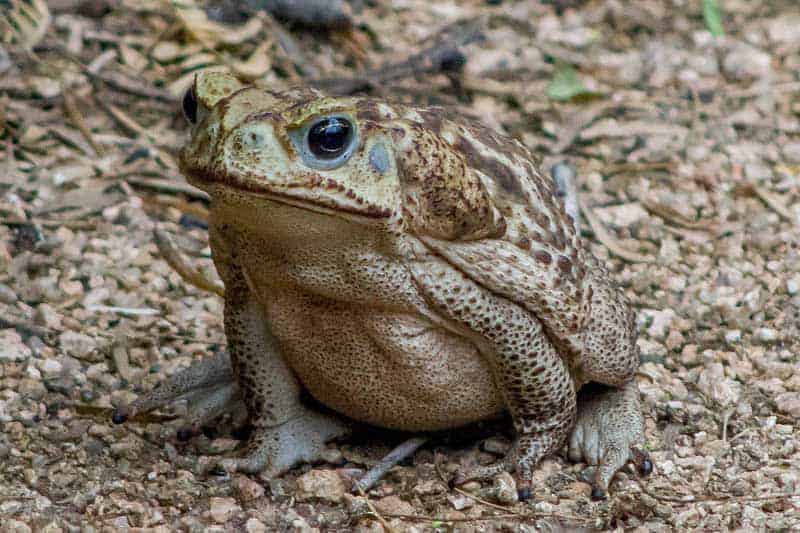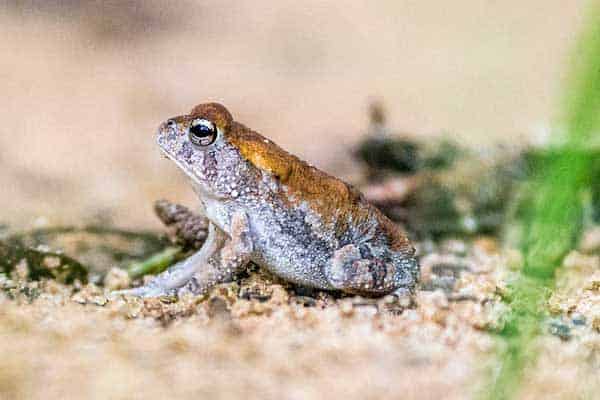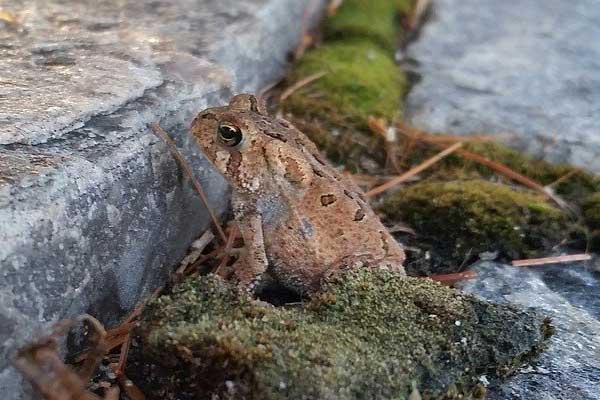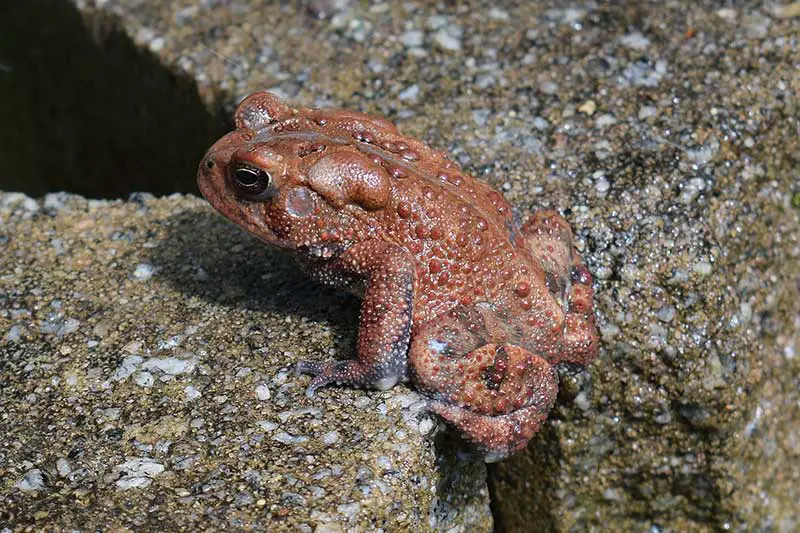You can find toads throughout North America as well as every continent in the world, except Antarctica. There are 6 different types of toads in Florida. They’re in the Family Bufonidae, and are known as true toads.
Florida has multiple ecosystems suitable for toads that are dependent on water to reproduce and lay eggs. The state has a coastline of 1,350 miles and a network of wetlands. The Green Swamp alone covers around 560,000 acres. These wetlands are protected by law, thus preserving the main habitats of toads. Florida also has substantial rainfall and humid weather conditions that toads enjoy.
Both toads and frogs are part of the Anura Order, but they are very different in their skin types and sounds. For example, toads have warts.
Continue reading to delve into more details about the 6 types of toads in Florida, providing valuable insights into Florida toads’ identification.
6 species of toads in Florida
The 6 species of toads in Florida are the marine toad, southern toad, Fowler’s toad, oak toad, eastern narrowmouth toad, and eastern spadefoot toad.
1. Marine toad (cane toad)

Scientific name: Rhinella marina
The Marine Toad is also called the Cane Toad or Giant Toad. As its name suggests, it is the largest toad in Florida, although considered an invasive species. An adult is usually around 4 to 6 inches in length but can grow up to 9.4 inches. These toads also have large parotoid glands behind their ears and at the back of their heads. Their color is usually yellowish, red-brown, grey, or olive-brown with different patterns.
Marine toads will eat all types of foods beyond insects, including native frogs and pet food. Their secretion is also highly poisonous. Even their tadpoles are toxic to most animals trying to eat them.
They are found mainly in urbanized habitats in parts of Southern Florida but also live in mangrove swamps and floodplains. From March through September, you can hear the males call a melodic trill.
2. Southern toad

Scientific name: Anaxyrus terrestris, formerly Bufo terrestris
The Southern toad is active at night and normally hides during the day. They enjoy living in marshes, hardwood swamps, and sandy locations throughout Florida. They are known to eat anything they can swallow, including earwigs, ants, mole crickets, snails, and cockroaches.
You can identify Southern toads from their crests and highly pronounced knobs on their heads. The crests run down to the snot from the knobs. Their color varies from red, black, or brown. They only have one or two warts and no dark spots.
These toads range from 1.7 inches to 4.5 inches in length as adults. They breed in the spring when males migrate from the uplands to pools, ditches, and swamps. Females will lay up to 4,000 eggs, which can take 55 days before they morph into juvenile frogs.
3. Fowler’s Toad

Scientific name: Anaxyrus fowleri, formerly Bufo fowleri
Fowler’s Toads are rust red, gray, brown, and olive green with black or dark brown spots on their backs. Each of these spots usually has three or more warts in them. They also have a cream stripe running down the middle of their back and whitish bellies and chests. An adult is typically 2 inches or 3.7 inches in length.
These toads can only be found in the Florida Panhandle. They enjoy living in marshes near sandy areas, irrigation ditches, rain ponds, and backyards. You can sometimes mistake them for American toads. However, Fowler’s toads take short, quick hops, and American toads make larger fewer hops. The Fowler’s toad also makes a muffled “whirr” sound that can sound similar to a sheep with a cold.
Females can lay up to 8,000 eggs at once during the February to April breeding season. The fertilized eggs typically hatch between 2 and 7 days, contributing to the perpetuation of this unique species among the toads of Florida.
4. Oak Toad

Scientific name: Anaxyrus quercicus, formerly Bufo quercicus
The Oak toad is the smallest toad in the U.S. Adults will generally grow up to 1.5 inches in length. You can identify these toads by the yellowish stripe running down the center of their back. Their body’s color ranges from dark brown to light gray with variable brown and dark spots.
As their name suggests, you can find these toads in pine-oak woods, oak savanna with sandy soils, oak scrubs, and maritime forests. They live throughout Florida. You can hear their chirping call when they breed during the summer. Listen out for the “cheep-cheep-cheep” sound they make.
The Oak toad eats mainly small insects and other arthropods. However, adults are known to have a strong preference for ants.
5. Eastern narrowmouth toad

Scientific name: Gastrophryne carolinensis
You can find the Eastern Narrowmouth throughout Florida, typically under logs, near ponds, sandy pinelands, and oak ridges. They need fishless waters to breed. Although it isn’t a true toad, it is terrestrial similar to other toads and one of the three species in the U.S. belonging to the Family Microhylidae.
These toads have round, oval-shaped bodies with narrow and pointed heads. They are identifiable by their colors. The back and legs are bluish with coppery irregular patterns, and their stomachs are multicolored.
The Eastern Narrowmouth toad is quite small, growing up to 2.1 inches in length. The males will make calls only when their snouts are protruding out of the water. It sounds like a nasal, high pitched, long “waaaaaaaah.”
6. Eastern spadefoot toad

Scientific name: Scaphiopus holbrookii
The Eastern Spadefoot enjoys living in mixed hardwood swamps and marshes. They are the only spadefoot species found east of the Mississippi River. In Florida, you can find them in almost all counties except a few in the south.
These toads got their name from the sharp-edged, black sickle-shaped spade on each of their hind feet. The spades allow them to burrow vertically into loose or sandy soils. They mostly live underground, coming up only during breeding time.
Spadefoot toads are one of the few toads without warts as well as have smoother and moister skin. This toad’s color ranges from yellowish or tan to dark brown without bold spots. They can grow up to 3.1 inches in length. People say its low-pitched call sounds similar to a crow.
FAQs About Toads
1. Are Toads Poisonous?
Yes, they are. Toads have paratoid glands that secrete poison to help them defend themselves. The secreted poison is called a bufotoxin that usually looks like a white, milky substance. It can kill small animals and cause allergic reactions to humans.
2. Can Toads Swim?
Yes, toads can swim and they are dependent on water for breeding and laying eggs. However, toads can survive longer without water compared to other frogs.
3. Can You Get Warts From Toads?
No, you cannot. Warts are caused by a virus that can only be transferred to humans from another human, not from toads.
4. What Predators Eat Toads?
Common predators of toads are raccoons, snapping turtles, snakes, and birds of prey. Two common snakes in Florida that eat toads are Hognose snakes and Garter snakes.
5. Are Florida Toads Endangered?
Florida’s protected wetlands prevent most toads from being endangered in the state. In Florida, Cane Toads are considered invasive species and you are encouraged to remove them from your property and protect your pets from them.




